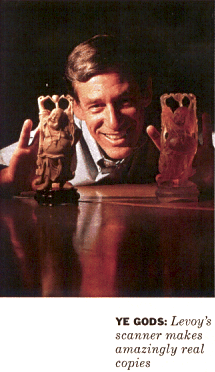![]()
STANFORD: EGGHEADS AND ENTREPRENEURSIts wizards keep the emphasis on how to market the bounty of knowledge  The exuberant Buddha statue in the right hand of Stanford computer science professor Marc Levoy is a trinket he picked up from a museum gift store. The amber-shaded identical twin in his left is a state-of-the-art original. Original computer graphic art, that is. Levoy has invented technology to scan items with a laser and then ''fax'' the resulting three-dimensional model to a remote stereo lithography machine, which fashions an exact copy out of plastic. Hollywood is salivating at the prospect of using this technology for special effects. It could also revolutionize art reproduction-- now a $1 billion industry, Levoy says. He recently had to decide whether to spend his sabbatical starting a company or pursuing a labor of love by scanning some of the world's most precious sculpture. He chose the latter. For now. You never know what new twist you'll find at Silicon Valley's Ground Zero--Stanford University's computer-science and electrical engineering departments. A Buddha in the graphics lab; a self-learning robot chugging down a corridor; a goggled grad student intently organizing a three-dimensional desktop only he can see. Or gadget-free artificial-intelligence refugee professor Terry Winograd talking with his students about why so many computer users feel they need to be ''polite'' to their machines. He's helping shape the field of ''interaction design,'' which is focused on how people work and behave with technology. FRIENDS OF BILL. For decades, Stanford's wizards have been exploring the technical frontiers of computing, training, and staffing the high-tech elite. The benefactor plaque in the slick new sandstone ''William Gates Computer Science'' building (as a measure of its reputation, Stanford snagged one of Gates' first significant philanthropic overtures--a $6 million gift in 1992) is a Valley Who's Who: The names include Hewlett-Packard, Cisco Systems, Silicon Graphics, and a slew of prominent venture capitalists like Reid Dennis and Donald T. Valentine. The university makes the same claims as every top academic center about hiring the smartest faculty and snagging the brightest students. But what seems to make Stanford really unique is an infectious entrepreneurial spirit. It's no coincidence that Levoy talks about the potential markets for his technology as comfortably as he does its technical elegance. ''People in our department don't often spin off into theory-land and irrelevance,'' says Edward A. Feigenbaum, a legendary artificial intelligence researcher currently on leave from Stanford's Knowledge Systems Laboratory. In an informal BUSINESS WEEK poll, Stanford was chosen as the place most researchers would like to work (page 116). Indeed, Stanford's deceptively laid-back, country-clubbish campus attracts those for whom developing products--and making a few million--is as alluring as publishing. Some, of course, do both: In 1984, John Hennessy--then dean of the School of Engineering--took a sabbatical and started MIPS Technologies Inc. The company, now a unit of Silicon Graphics Inc., exploited his pioneering work in RISC chip architectures. Now back at Stanford, Hennessy says the whole field is asking how to ''make technology do things the way people want to do them.'' In that quest, Stanford is beefing up research in graphics, user interfaces, and information handling. One project is aimed at standardizing digital presentation of different data types, including images, sounds, and text. On the programming frontier, consulting faculty member John Koza is using genetic algorithms to prepare thousands of random programs that run on a massively parallel supercomputer. The machine combines and recombines the programs to come up with usable solutions to mathematical problems. Koza says he has used the approach to crack one of the thorniest challenges in electrical engineering: designing complex analog circuits for sound amplifiers. This work, says Koza, used to be the domain of revered artisan/engineers ''off in a room wearing purple hats with gold stars'' gradually tweaking old designs to fit new parameters. Koza's approach could automate the process and could be commercial in about five years. Once again, the allure of the cutting edge--and commensurate profits--makes this place tick. Says Hennessy: ''The gap between research and what's in production has narrowed to almost nothing.'' By Joan O'C. Hamilton in Palo Alto, Calif.
|
Updated June 12, 1997 by bwwebmaster
Copyright 1997, by The McGraw-Hill Companies Inc. All rights reserved.
Terms of Use